 |
|

|
 |
TABLE of CONTENTS
 |
Program boosts economic development, improves transportation system |
By Sue Roe
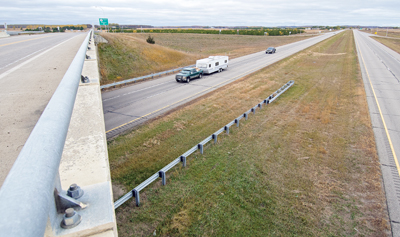
This interchange at Hwy 10 and County Road 34 in Perham is an example of a 2010-11 TED funded project. The interchange created better access to three businesses and a new hospital. It also supported the creation of 240 jobs. Photo by David Gonzalez |
The Minnesota Department of Transportation is partnering with the Department of Employment and Economic Development to offer matching funds to Minnesota cities, counties and other government entities for transportation infrastructure projects that support economic development.
The Transportation Economic Development, or TED program is a competitive grant program designed to help meet the state’s transportation and economic development needs by creating and preserving well-paying jobs and leveraging private and local investment in transportation infrastructure. Application deadline is Sept. 25.
A total of $30 million is available in this year’s solicitation. This includes $28 million in MnDOT trunk highway funds and $2 million of DEED general obligation bond funding. The funding will be split between projects in Greater Minnesota and the Twin Cities.
“There’s been a great amount of economic development throughout the state because of this program,” said Commissioner Charlie Zelle. “Transportation investments can create new jobs and spur economic growth in our communities.”
Projects must support one or more of several industries, including manufacturing, technology, warehousing and distribution, research and development, agricultural processing, bioscience, tourism/recreation and industrial park development. The TED program solicitation website has a complete list of eligibility guidelines.
Projects will be selected on the basis of transportation impact, statewide economic impact, project financial plan and project readiness.
“The TED program is great collaboration between MnDOT, DEED and local units of government that help to advance projects that can deliver strong transportation enhancements along with economic development,” said Ken Buckeye, TED program project manager. “In some cases, where qualifying private sector contributions are involved, we are able to further leverage program resources. Information sessions that we are holding in each district will help potential applicants better understand the program goals and the application requirements.”
The TED program has provided more than $77 million in grants to 28 projects throughout the state since 2011. This investment leveraged nearly $120 million in local government and private funds. See previous TED-funded projects.
|
 |
|

|
 |
TABLE of CONTENTS
 |
Metro, CO mourn loss of Rocky Haider |
By Sue Roe
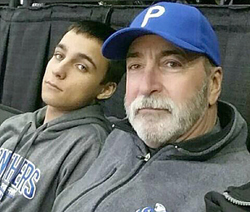
Rocky Haider, state program administrator principal in the state Maintenance Office, died July 30. Haider, pictured with his grandson Victor, enjoyed spending time with his family. Photo courtesy of Haider family |
Steven “Rocky” Haider, Sr., state program administrator principal, died July 30 while in hospice care. He worked for MnDOT for more than 25 years in the Metro District and at Central Office.
Haider started as a highway maintenance worker at the Camden Truck Station in the Metro District in 1990. He moved to Equipment Coordination in Roseville in 1997 and was promoted a year later to information technology specialist 2 in Automation Support. In 1999, he moved to Maintenance Administrative Support and in 2000 he became transportation program specialist 2. He was promoted to state program administrator principal in the state maintenance office in St. Paul in 2000.
Haider had been off work since April 9 as a recipient of the state vacation donation program.
Sue Lodahl, Office of Maintenance, was Haider’s supervisor for 15 years.
“Rocky was very dedicated to MnDOT. He took pride in his work and was instrumental in bringing Business Intelligence to the maintenance community,” said Lodahl. “He would go to the moon and back for anyone he cared for. His family was very important and raising his grandson, Victor, made him stronger and kept his life alive. He will be remembered and missed. His battle with cancer ended too quickly.”
Brad Lechtenberg, Office of Maintenance, who worked closely with Haider, said he had a passion for excellence and had no problem telling people when they weren’t doing a good job.
“He had the ability to say things no one else could and many times appeared hard, but always with an ironic humor lurking just beneath the surface,” Lechtenburg said. “Rocky wasn't just another employee or hard working coworker. Rocky was a presence. He had a very entertaining wit and could be both bombastic and hilarious at the same time.”
“Everyone liked Rocky and his family became very important to him, particularly the last few years of his life. It was my privilege to have worked with Rocky for 15 years and to have been his friend. We'll miss him,” he said.
Wade Adams, transportation specialist 3, started working with Haider in St. Paul about the time Haider started receiving chemotherapy.
“Rocky had a very unique personality and was always doing or saying something to make people laugh. My favorite memory is of him and his boss, Sue Lodahl, bantering back and forth with each other from the time they walked into the office until the time they went home. I will always appreciate the time I worked with him as he was very knowledgeable and taught me a lot of things that will help me in the future,” Adams said. “He will truly be missed.”
Services were Tuesday, Aug. 4 at the Wulff Godbout Funeral Home, St. Paul, with burial in Fort Snelling National Cemetery.
He is survived by seven children, four brothers, four sisters, 24 grandchildren, including one grandson, Victor Hernandez, who was living with him at the time, and three great-grandchildren. |
 |
|

|
 |
TABLE of CONTENTS
 |
New planning internship program draws students from around the country |
|
By Jake Rueter, Office of Transportation System Management
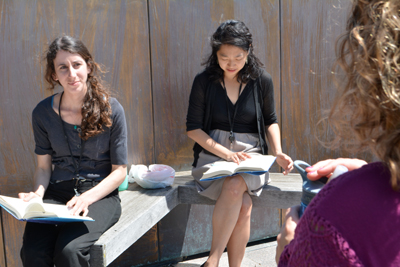
Graduate students Katie O’Sullivan, left, and June Koo discuss the book, Move: Putting America’s Infrastructure Back in the Lead, with principal planner Katie Caskey. The summer planning interns participate in MnDOT’s weekly planning book club that meets over the lunch hour. Photo by Shannon Fiecke |
MnDOT’s Transportation System Management and Transit offices are enjoying the help of a few extra hands on deck this summer.
Rebecca Barney, June Koo, Katie O’Sullivan and Alex Schieferdecker are the first participants in MnDOT’s inaugural Planning Internship Program. The program started this year as a way to expose current and recent students to state-level, system-wide transportation planning; develop partnerships with educational institutions; bring new energy and fresh perspectives to MnDOT and develop a diverse pool of professionals with experience in state-level transportation planning.
The interns join MnDOT from diverse educational programs at universities in New York, Massachusetts and Minnesota.
“MnDOT’s focus on multi-modalism and health made it a very appealing entry point to state-level transportation planning,” said O’Sullivan, a student at the University at Albany – SUNY. “I’ve been able to learn from staff all over the agency, who have been so generous in sharing their knowledge and experiences related to multimodal planning, complete streets, climate change adaptation and more.”
Barney, an intern from the University of Minnesota, was interested in working for MnDOT because she wants to “better understand the system that governs how we develop our transportation networks.”
In addition to being involved with ongoing projects like Safe Routes to School planning and the joint update of the Statewide Multimodal Transportation Plan and Minnesota State Highway Investment Plan, the interns can participate in a number of professional development opportunities. They include a tour of sustainable infrastructure led by Environmental Stewardship, an upcoming visit to the Southwest Light Rail Transit project office and weekly lunch discussions with MnDOT’s planning book club.
MnDOT’s Planning Internship Program will continue on an annual basis during the summer months. For more information on hosting an intern next year, contact Jake Rueter or visit the program website. |
 |
|

|
 |
TABLE of CONTENTS
 |
Legislative proposals due Aug. 21 |
|
The 2016 legislative session may be months away, but MnDOT is starting the process to develop legislative proposals now. The deadline to submit proposals is Friday, Aug. 21. Proposals should be submitted to Erik Rudeen, Government Affairs. The proposal form and more information are available at http://ihub/governmentaffairs/legislative2016/index.html
Proposals need approval from division directors and office directors before they can be submitted.
MnDOT leadership will review the proposals starting in September and legislative initiatives and draft legislation will be submitted to the governor’s office and Minnesota Management and Budget Oct. 1. The 2016 legislative session begins March 8, 2016. |
|
 |
|

|
 |
TABLE of CONTENTS
 |
Planning team wins award for MnSHIP |
|
By Rich Kemp
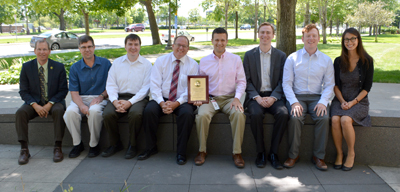
Members of the planning team for the 20-Year State Highway Investment Plan included from left: Tim Henkel, Modal Planning and Program Management Division director; Mark Gieseke, Transportation System Management Office director; Brian McLafferty, performance measurement coordinator; Patrick Weidemann, capitol planning director; Ryan Wilson, transit corridor engineer; Brad Utecht, Met Council (formerly with MnDOT); Shawn Combs Walding, senior engineer; and Mei-Ling Smith, Minneapolis city planner (formerly with MnDOT). Not pictured is Kathleen Mayell, Investment Planning director. Photo by Rich Kemp |
The U.S. Department of Transportation’s Federal Highway Administration and Federal Transit Administration announced July 14 that MnDOT received one of this year’s eight Transportation Planning Excellence Awards.
“Building a world-class transportation system doesn’t happen overnight, and never by accident,” said U.S. Transportation Secretary Anthony Foxx. “These awards recognize the critical role planning plays in meeting America’s future transportation challenges.”
MnDOT was recognized for the 20-Year State Highway Investment Plan, which draws on public input to guide capital investment plans for transportation projects along the state’s 12,000-mile network of highways. It represents the sort of formalized, long-term planning needed by state and local transportation officials nationwide to make the most of increasingly limited transportation funding.
“We had a very energetic and creative team who were determined to incorporate lots of new ideas, including new approaches to public involvement and risk management,” said Mark Gieseke, Transportation System Management Office director. “I think we all felt that we were working on something very special and we are honored to be recognized with this award.
According to the 2013 MnSHIP, the state is fiscally constrained to $18 billion in transportation spending over the next 20 years. However, MnDOT officials estimate its needs are nearly double that – about $30 billion. The $12 billion gap is one of the primary reasons for a focused, highly prioritized plan that ties transportation funding to performance.
“Good projects are the result of good planning,” said Gregory Nadeau, acting Federal Highway administrator. “A disciplined, long-term vision of the state’s transportation needs in the coming decades is not just good government – it is smart government.”
Selected by an independent panel, the awards are a biennial recognition by the FHWA and FTA of outstanding transportation planning practices performed by planners and decision makers in communities across the country.
This year, eight winners were selected of 35 TPEA submissions from around the country. Criteria for selection included: community, public involvement and partnerships; context sensitive solutions; innovation and effectiveness; equity; implementation and strategy; multi-modalism; and potential for long-term benefits.
“It’s important to recognize the creative efforts of the nation’s transportation planners,” said Therese W. McMillan, acting Federal Transit administrator. “The future of our infrastructure
system begins with their vision.”
Additional information about the 2015 TPEA recipients can be found at http://www.fhwa.dot.gov/planning/tpea/2015/ |
 |
|

|
 |
TABLE of CONTENTS
 |
Advocacy Council for Tribal Transportation provides smooth path to strengthen tribal relations |
By Sue Mulvihill
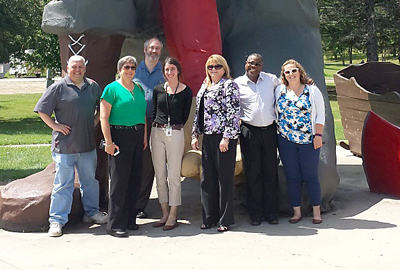
Some of the MnDOT employees at the July 17 ACTT meeting included from left: Bob Wolbeck, senior research analysis specialist; Sue Mulvihill, deputy commissioner/chief engineer; Peter Morey, senior transportation program supervisor; Katie O’Sullivan, summer planning intern; Laurie Ryan, strategic freight partner relations; John Tompkins, Freight Project manager/MFAC coordinator and Katie Caskey principal planner. Photo courtesy of ACTT |
Transportation is a critical issue to Minnesota tribes. So are communications between them and the many agencies with road jurisdictions. This includes local governments, MnDOT and the Federal Highway Administration to ensure the development of reservation-area transportation systems that are safe and efficient and meet the needs of tribal members, the traveling public and businesses moving goods in, around and through our state.
To facilitate two-way dialogue and results, the Advocacy Council for Tribal Transportation was founded nine years ago. Its members meet regularly to discuss roadway policy and issues involving roadways on or near Minnesota’s Indian reservations.
In Minnesota, there are 11 Native American tribes that live on seven Anishinaabe (Chippewa, Ojibwe) reservations and in four Dakota (Sioux) communities. All of the tribes are represented with members in ACTT, along with representatives from the FHWA, Bureau of Indian Affairs, Michigan Tribal Technical Assistance Program, Minnesota Indian Affairs Council, and county and city governments. Rounding out the group is MnDOT, with our tribal liaison Ed Fairbanks, District 1 and District 2 engineers Duane Hill and Craig Collison and myself as members.
ACTT members provide a vital link and assistance to MnDOT’s tribal liason for the scheduling of formal consultation meetings and providing aid and support for implementation of the Tribal-State Relations Training, both required by Gov. Dayton’s Executive Order 13-10. ACTT members assist in hosting this important training and have personally attended and participated to ensure high-quality and accurate training is provided to state employees.
Ed’s role with ACTT is just one of the many efforts he is actively involved in to build and enhance MnDOT tribal relationships. In maintaining government-to-government relations with tribal representatives and their communities, he arranges meetings between them and our Commissioner, engineers, planners and others from Central Office and the MnDOT districts.
Since the first ACTT meeting in September 2006, where tribal road signs and roadside vegetation were the pressing topics of the day, groups were formed to work on specific issues and many have been addressed by the group to date. In the two years that I have served on ACTT, new partnerships have been formed and I have seen progress with the level of discussions pertaining to transportation system items, enhanced intercommunication between tribes on transportation issues, and greater engagement of ACTT with FHWA.
I am especially pleased with the fact that the ACTT membership is no stranger to our own Minnesota GO and MnDOT’s “Family of Plans.” In fact, at the most recent ACTT meeting, hosted by the Leech Lake Tribe on July 17 at Northern Lights Casino in Walker, Minn., attendees were given presentations and solicited for feedback by representatives from multiple MnDOT offices.
As returning guests, the Transit Office gave updates on the Statewide Pedestrian System Plan and Safe Routes to School efforts. Additionally, the Transportation System Management Office gave a State Highway Map and Mapping Project update presentation on tribal boundaries. Attendees also heard about tribal participation opportunities for the Statewide Multimodal Transportation Plan update.
To top it off, the Office of Freight and Commercial Vehicle Operations presented information on the current development of the 2015 Statewide Freight System Plan and the restructuring and advancement of the Minnesota Freight Advisory Committee. Both highlighted multiple participation opportunities and included invitations for tribal involvement. The significant role of freight throughout Minnesota and its importance to quality of life, economic competitiveness and environment health for the tribes and our state was explained. Attending members responded with freight suggestions, their interests and concerns, and other feedback that will be addressed in the development of the freight plan.
By attending these ACTT meetings, tribal representatives not only have the opportunity to provide face-to-face input, direction and feedback directly to planners and MnDOT leadership, but they are able to do so at a critical time when their input can directly impact and shape the plans. You could say participating tribal and other transportation leaders are “ACTT-ing” in the best interest of all when they attend ACTT meetings to ensure a “two-way street” today and a smoother road for tomorrow.
More information about ACTT, including meeting minutes and council members is available at www.dot.state.mn.us/mntribes/advocacycouncil.html. Websites of tribal communities and links to other related resources are listed at http://mn.gov/portal/government/tribal/mn-indian-tribes.
|
 |
|
| |
|



